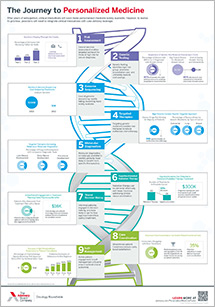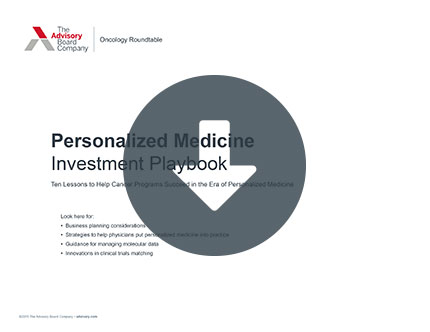Auto logout in seconds.
Continue LogoutIdentical twins Charlsie and Carly Agro bought home ancestry DNA kits from five major testing companies and got differing results, showing the limits of consumer-facing DNA testing.
Here are 8 clinical technologies that could transform health care delivery
Identical twins, different ancestries?
For a CBC investigation, Charlsie, a host for CBC's "Marketplace," and her sister Carly sent DNA samples to five major DNA ancestry companies:
- 23andMe;
- AncestryDNA;
- FamilyTreeDNA;
- LivingDNA; and
- MyHeritage.
When they got their results, the Agro sisters were surprised—they didn't receive matching results from any of the five companies despite having nearly identical DNA. For example, according to 23andMe, Charlsie had almost 10% less "broadly European" ancestry than Carly did, and Charlsie had 2.6% French and German ancestry that Carly didn't.
Charlsie asked Mark Gerstein, a computational biologist from Yale University, and his team to analyze the raw data set they sent to each DNA testing company. Gerstein's team concluded the Argo twins should have had identical DNA test results because the raw data sent to each company was statistically the same.
What happened?
So why did the twins have different DNA tests? Gerstein suspects the differences stem from the algorithms each ancestry DNA company uses to analyze the raw data.
"The story has to be the calculation. The way these calculations are run are different," Gerstein said.
According to Vox, DNA samples have around three billion parts to them, and all humans have about 99.9% of their DNA in common. So, to pick out the differences, DNA testing companies hone in on the parts called single nucleotide polymorphisms (SNPs) that typically vary by person.
The variations in SNPs can account for why people have different heights and different eye colors. They can be useful as starting points for analyzing a person's ancestry, because SNPs are passed down through generations. When two people have more SNPs in common, they're more likely to have common ancestry, according to Vox.
When a DNA testing company receives a DNA sample, they feed it into a machine called a genotyping array, which goes through the sample and tells the company which versions of SNPs are the same and where in the genome they are located. The problem is, while these machines are very accurate, they're not perfect, according to Yaniv Erlich, chief science officer at MyHeritage.
"We're talking about 99.9% accuracy for these arrays," he said, which means that while errors don't happen often, they still can happen, and those errors could explain why a set of twins would get different test results.
There's also the matter of reference groups. DNA testing companies will compare the set of SNPs in one DNA sample to a reference group made up of a select number of DNA samples of ancestry that's already known. However, every company can use different reference groups, and these groups often rely on people who are self-reporting their ancestry, which increases the chance of error.
There's also another complication. Many ancestries can look very similar genetically. For example, Erlich said, "There is very little [genetic] variation in Europe." People from England and people from Ireland aren't all that different genetically, which means the computer might say a person has English ancestry rather than Irish, Erlich explained.
How to interpret your ancestry results
It's important to remember that these DNA tests don't tell you where your ancestors live, per se, but rather how much DNA you inherited, Vox reports. According to Joe Pickrell, a geneticist and the CEO of Gencove, said, "It's possible that your brother might have inherited a piece of DNA from one of your ancestors that you did not," which means two siblings could get two different DNA test results.
All of this is to say it's important to take these tests with a grain of salt, Gravel said. They're not the same as standard diagnostic medical testing, but rather a "recreational scientific activity," he said (Agro/Denne, "Marketplace," CBC News, 1/18; Resnick, Vox, 1/28).
What providers need to know about genetic testing
In 2017, nearly 1 in 25 Americans had access to their genetic data—and many are showing up to their annual wellness visit looking for answers to their genetic test results. Some projections suggest that the direct-to-consumer genetic testing market will triple by 2022.
Here's a roundup of our blog posts, insights, and research on the topic so your organization can take the best approach to this technology.
- Blog post: How to prepare physicians to talk about medical genetics (and why to put them in charge)
- Blog post: Time for your annual physical—and genetic screening test?
- Blog post: Up to 35% of patients would switch PCPs for genetic testing. But is it a good investment for you?
- Blog post: How should you provide and bill for genetic counseling?
- Briefing: Evaluating the Opportunity in Genetics and Personalised Medicine
- Research report: Oncology Personalized Medicine Investment Playbook
Don't miss out on the latest Advisory Board insights
Create your free account to access 1 resource, including the latest research and webinars.
Want access without creating an account?
You have 1 free members-only resource remaining this month.
1 free members-only resources remaining
1 free members-only resources remaining
You've reached your limit of free insights
Become a member to access all of Advisory Board's resources, events, and experts
Never miss out on the latest innovative health care content tailored to you.
Benefits include:
You've reached your limit of free insights
Become a member to access all of Advisory Board's resources, events, and experts
Never miss out on the latest innovative health care content tailored to you.
Benefits include:
This content is available through your Curated Research partnership with Advisory Board. Click on ‘view this resource’ to read the full piece
Email ask@advisory.com to learn more
Click on ‘Become a Member’ to learn about the benefits of a Full-Access partnership with Advisory Board
Never miss out on the latest innovative health care content tailored to you.
Benefits Include:
This is for members only. Learn more.
Click on ‘Become a Member’ to learn about the benefits of a Full-Access partnership with Advisory Board
Never miss out on the latest innovative health care content tailored to you.


